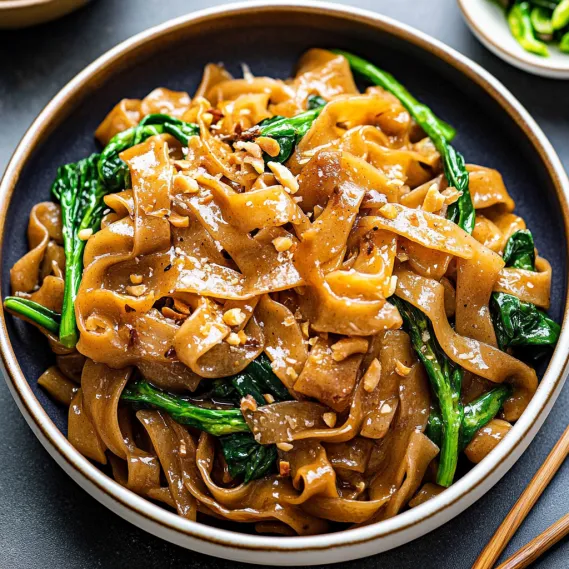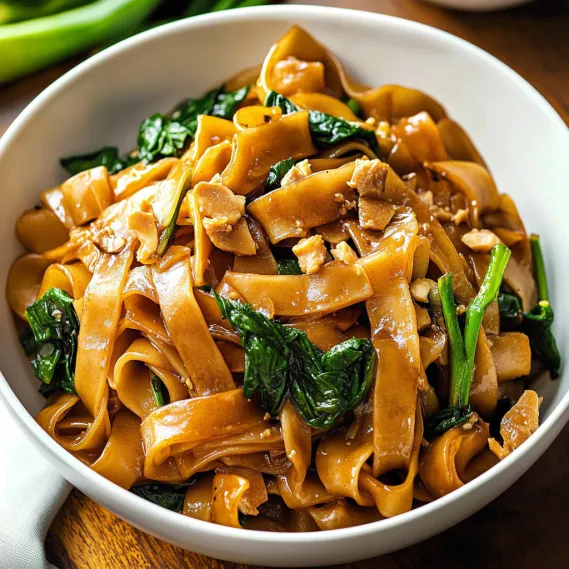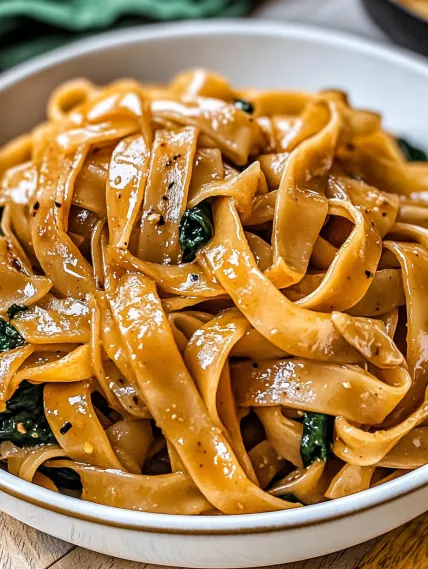 Pin
Pin
This hearty Pad See Ew brings authentic Thai street food right to your dining table. The combination of wide rice noodles, tender chicken, and Chinese broccoli bathed in a savory-sweet sauce creates a restaurant-quality dish that's surprisingly simple to make at home.
I first attempted this recipe after returning from a trip to Bangkok, desperate to recreate those unforgettable street food flavors. After several tries and a few smoky kitchen incidents, this version has become my family's most requested weeknight dinner.
Ingredients
- Wide rice stick noodles: The foundation of this dish, providing the perfect chewy texture to absorb the flavorful sauce.
- Dark soy sauce: Adds the signature deep color and rich flavor that defines authentic Pad See Ew.
- Oyster sauce: Contributes essential umami depth look for bottles labeled "premium" for best results.
- Light soy sauce: Provides the salt element without overwhelming the other flavors.
- White vinegar: Balances the sweetness with a subtle tang.
- Sugar: Necessary for achieving that authentic sweet-savory balance Thai food is known for.
- Peanut or vegetable oil: Use fresh oil with high smoke point for proper noodle caramelization.
- Garlic: Fresh cloves minced just before cooking release maximum flavor.
- Chicken thighs: Juicier and more forgiving than breast meat when stir-fried at high heat.
- Egg: Creates silky richness throughout the dish.
- Chinese broccoli: Provides a slightly bitter contrast that balances the sweet-savory sauce perfectly.
How To Make Pad See Ew
- Prepare the components:
- Take time to organize all elements before heating the wok. Slice chicken into uniform pieces about 1/4 inch thick for even cooking. Wash Chinese broccoli thoroughly and separate stems from leaves as they cook at different rates. Mix sauce ingredients in a small bowl until sugar completely dissolves.
- Cook noodles properly:
- Follow package directions precisely, but aim for slightly firmer than al dente as they'll continue cooking in the wok. Rinse immediately after cooking to stop the cooking process and prevent sticking. Time this step so noodles are ready just as you need them.
- Cook protein and vegetables:
- Heat your wok until it just starts smoking before adding oil. Cook garlic just until fragrant about 15 seconds before adding chicken. Add broccoli stems first then leaves, allowing each component to cook properly. The egg should be scrambled quickly in a cleared space within the same wok.
- Caramelize the noodles:
- This is the crucial step that separates good Pad See Ew from great. Remove everything from the wok first, then heat fresh oil until smoking before adding noodles and sauce. The intense heat creates those prized caramelized edges. Resist the urge to constantly stir limit yourself to just enough tosses to distribute the sauce.
- Combine and serve:
- Quickly reintroduce the chicken mixture to the caramelized noodles with minimal tossing. The entire dish should move from wok to plate in under 30 seconds to preserve the perfect texture and temperature.

My breakthrough moment with this recipe came when I finally stopped stirring the noodles constantly. That patience allowed the edges to develop that magical caramelization you find in the best Thai restaurants. Now whenever I smell that distinctive aroma of caramelizing rice noodles, it transports me straight back to the bustling night markets of Bangkok.
Troubleshooting Sticky Noodles
If your rice noodles clump together after cooking, avoid the temptation to rinse with cold water. Instead, toss with a small amount of neutral oil immediately after draining. When preparing dried rice noodles, soak them until they're pliable but still slightly firm in the center. They'll finish cooking in the wok, absorbing the flavorful sauce while maintaining their integrity. If using fresh rice noodles, a quick 5-second microwave loosens them perfectly for stir-frying.
Make It Your Own
This recipe welcomes adaptation based on what you have available. Swap chicken for thinly sliced beef, pork, tofu, or shrimp. If Chinese broccoli proves difficult to find, substitute regular broccoli, bok choy, or even spinach. While traditional Pad See Ew contains just a few simple vegetables, feel free to add julienned carrots or bell peppers for extra color and nutrition. The sauce works beautifully with whatever protein and vegetables you choose, making this a perfect clean-out-the-fridge meal.

The Secret's in the Sauce
The deceptively simple sauce is what gives Pad See Ew its distinctive flavor profile. Dark soy sauce provides color and depth, while light soy delivers saltiness. Oyster sauce contributes essential umami notes that can't be replicated with other ingredients. The balance of sugar and vinegar creates that characteristic Thai sweet-sour foundation. For an extra dimension, try adding a teaspoon of fish sauce or replacing the white vinegar with rice vinegar. Store any leftover sauce in the refrigerator for up to a week it makes an excellent quick marinade for midweek proteins.
Recipe FAQs
- → What type of noodles are best for Pad See Ew?
Wide flat rice noodles, such as Sen Yai, are traditionally used for Pad See Ew. If unavailable, dried rice stick noodles make a great substitute.
- → Can I use a different protein instead of chicken?
Yes, you can substitute chicken with beef, pork, shrimp, or tofu. Adjust cooking times accordingly to ensure your protein cooks through properly.
- → How do I get the caramelized flavor on the noodles?
Cook the noodles in a very hot wok or skillet with minimal tossing. This allows the sauce to caramelize and enhances the flavor.
- → What is the key to balancing the flavors in Pad See Ew?
The combination of dark soy sauce, oyster sauce, light soy sauce, vinegar, and sugar creates a perfect balance of savory, sweet, and tangy flavors. Adjust to taste if desired.
- → Can I make Pad See Ew vegetarian or vegan?
Absolutely! Use tofu as your protein and substitute oyster sauce with a vegetarian oyster sauce or hoisin sauce for a vegan-friendly version.
